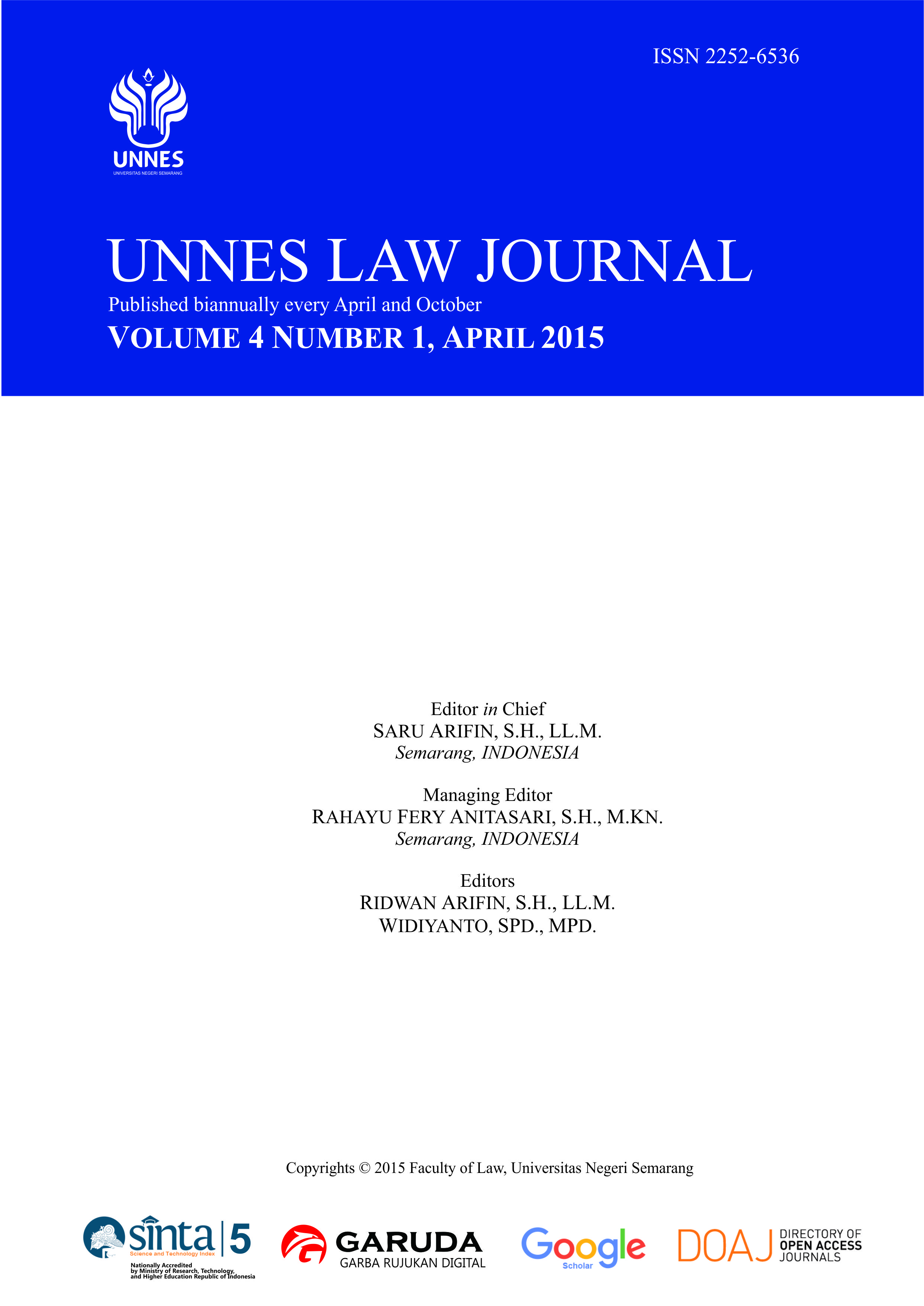LGBT in Legal and Criminology Aspects Criminology, Law and Gender
Main Article Content
Abstract
The LGBT which is an acronym for Lesbian, Gay, Bissexual and Transgender is a group consisting of people who have sexual orientation deviations, behavioral deviations and appearances that are not in accordance with their gender. The current LGBT phenomenon has experienced rapid development in everyday life. LGBT as a form of sexual deviation, behavioral irregularities and appearance that is not in accordance with their gender, has expanded to a society with a normal social order, even these LGBT actors are not only teenagers and adults but also children. Most LGBT people present themselves as heterosexual people, this is done so that LGBT people can get along comfortably in carrying out various social activities in the community. The deviation itself does not rule out the possibility of being in campus life and the perpetrators are students to lecturers. The proliferation of television coverage of LGBT has also expanded the movement of LGBT people to show their identity that they exist. This report will discuss the observations of LGBT communities on campus (UNNES) and how they relate to crimonology and victimology.
Article Details
References
• Ali, Rianto. 2005. Metodologi Penelitian Sosial dan Hukum. Jakarta: Granit.
• Atmasasmita, Romli. 2005. Definisi Kriminologi. Bandung: Tarsito.
• Burhan, Bungin. 2001. Metode Penelitian Sosial. Surabaya: Airlangga University Press.
• Efendy, Rusli. 1993. Ruang Lingkup Kriminologi, Bandung: Alumni.
• Lexi, Moleong J. 2006. Metode Penelitian Kualitatif. Bandung: PT Remaja Rosadakarya.
• Moeljatno.1986. Kriminologi. Jakarta: Bina Aksara.
• Muljono, Wahyu. 2012. Pengantar Teori Kriminologi. Yogyakarta: Penerbit Pustaka Yustisia.
• Ridwan, H.M dan Ediwarman. 1994. Azas-Azas Kriminologi. Medan: USU Press.
• Santoso, Topo dan Eva Achjani Zulfa. 2011. Kriminologi. Jakarta: Rajawali Press.
• Sugiyono. 2011. Metode Penelitian Kombinasi. Bandung: Alfabeta.
2. Jurnal Nasional dan Internasional:
• Arrasjid, Chainur. Suatu Pemikiran Tentang Psikologi Kriminil. Kelompok Studi Hukum dan Masyarakat. Medan: Fakultas Hukum USU.
• Azmi, Khilman Rofi. 2015. Enam Kontinum dalam Konseling Transgender Sebagai Alternatif Solusi Untuk Konseling LGBT. Jurnal Psikologi Pendidikan dan Konseling. Vol.1 No.1.
• Boelstorff, Tom. 2005. Gay Archipelago. Priceton and Oxford, USA.
• C, Silverstein,. 1998. The Borderline Personality Disorder and Gay People, Journal of Homosexuality, Vol. 15 No. 1–2.
• Dermawan, M. Kemal. 2001. Pencegahan Kejahatan: Dari Sebab Sebab Kejahatan Menuju Pada Konteks Kejahatan. Jurnal Kriminologi Indonesia, Vol. 1 No.3.
• Erniwati. 2015. Kejahatan Kekerasan Dalam Perspektif Kriminologi. Mizani. Vol. 25 No. 2.
• Hagan, Jhon. 1987. Modern Criminology: Crime, Criminal and Behavior and I ts Control. McGraw Hill Book Com, Singapura.
• Hardianto dan Nurul Q. 2018. Penerapan Teori Teori Kriminologi dalam Penanggulangan Kejahatan. Pandecta. Vol. 13 No. 1.
• Johns, Michelle Marie. 2013. LGBT Community, Social Network Characteristic, and Smoking Behaviors in Young Sexual Minority Women. Am J Community Psychol. University of Michigan, Am Arbor, MI. USA
• Karnadi, Rustam Dahar. 2016. LGBT DI INDONESIA: Perspektif Hukum Islam, HAM, Psikologi dan Pendekatan Maṣlaḥah. Al Hakam. Universitas Islam Negeri Walisongo, Semarang. Vol. 26. No. 2.
• L, Dean., Meyer, I. H., Robinson, K., Sell, R. L., Sember, R., Silenzio, V. M. B., … White, J. 2000. Lesbian, gay, bisexual, and transgender health: Findings and concerns. Journal of the Gay and Lesbian Medical Association.Vol. 4.
• Lilik Mulyadi. 2009. Kajian Kritis dan Analisis Terhadap Dimensi Teori-teori Kriminologi dalam Perspektif Ilmu Pengetahuan Hukum Pidana Modern. Malang.
• M. J, Eliason,., Dibble, S. L., & Robertson, P. A. 2011. Lesbian, Gay, Bisexual, and Transgender (LGBT) Physicians’ Experiences in the Workplace. Journal of Homosexuality Vol. 58 No.10.
• Muttaqin, Imron. Membaca Strategi Eksistensi LGBT di Indonesia. Raheema: Jurnal Studi Gender Anak. UIN Maulana Malik Ibrahim. Malang.
• Papilaya, Jeanete Ophillia. 2016. Lesbian, Gay, Biseksual, Transgender (LGBT) dan Keadilan Sosial. Jurnal Humaniora Yayasan Bina Darma.
• Ritonga, Elfiyanti. 2019. Komunikasi Komunitas Khusus LGBT. Jurnal Komunika Islamika: Jurnal Ilmu Komunikasi dan Kajian Islam. Vol.5. No.2
• S, Campbell. 2013. Sexual Health Needs And The LGBT Community. Nursing Standard (Royal College of Nursing), Great Britain.
• S. D, Johnson. 2012. Gay Affirmative Psychotherapy With Lesbian, Gay, and Bisexual Individuals: Implications for Contemporary Psychotherapy Research. American Journal of Orthopsychiatry. Vol. 82 No.4.
• Santoso, Meilany Budiarti. LGBT dalam perspektif Hak Asasi Manusia. Social Work Jurnal. Vol.6 No.2. Universitas Padjajaran.
• Suryakusuma.1991. Penelitian Transgender dan Perubahan Sosial. Jakarta: Jurnal Penelitian LIPI. Dalam Prisma. Vol.7.
• Traub, Stuart H. and Craig B. Little. Theories of Deviance. F. E. Peacock Publisher to Inc., New York.
• William III, Frank P. and Marilyn McShane. 1984. Criminological Theory. New Jersey Printice hall. Englewood Cliffs.
3. Sumber Online:
• Jawa Pos Radar Semarang.
• http://www.suara.com/news/2015/07/06/060400/berapa-jumlah-gay-lesbian-diindonesia , diakses pada pukul 14.45 WIB tanggal 4 Mei 2019.
4. Peraturan Perundang-undangan:
• Kitab Undang-Undang Hukum Pidana (KUHP).
